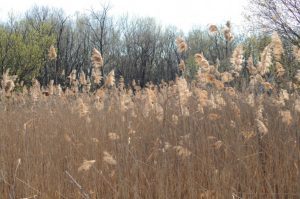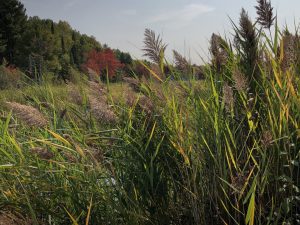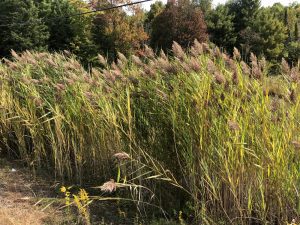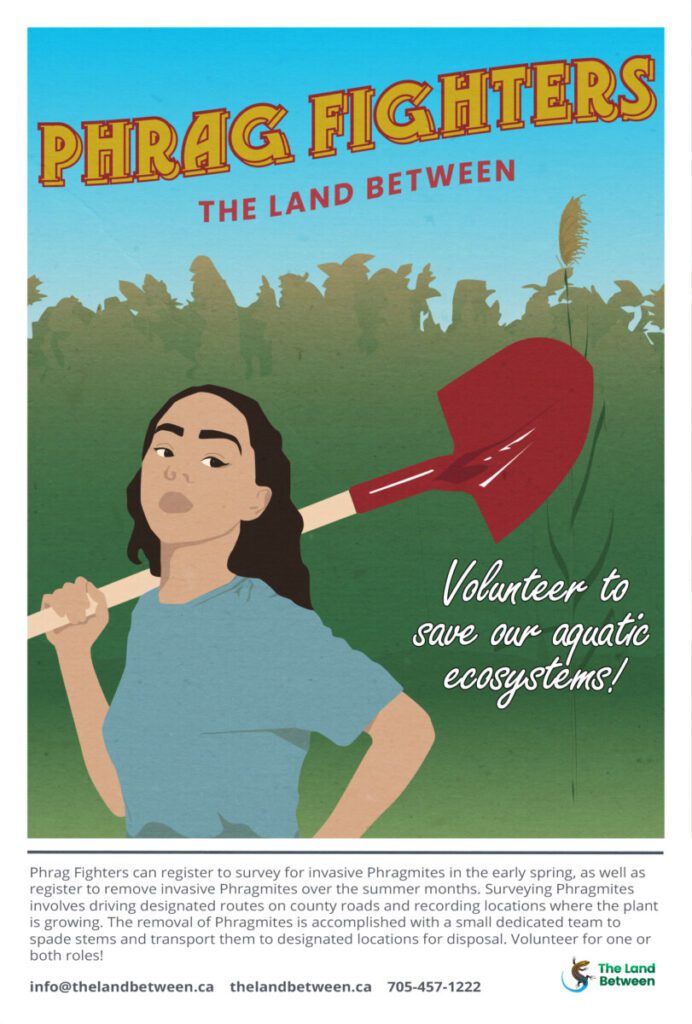Phragmites australis australis, otherwise known as European Common Reed or Invasive Phragmites, is a fast-spreading, perennial aquatic grass found growing in wetlands, shorelines and roadside ditches. This aggressive plant crushes biodiversity by outcompeting our native plants. In 2005, Invasive Phragmites was named Canada’s worst invasive plant species by Agriculture and Agri-food Canada.
What Does It Look Like?

Invasive Phragmites is a tall (up to 5 meters), densely growing grass. It has broad, flat, blue-green leaves and purple-yellow plumes (flowers) that grow on the end of each stalk. Stalks produced in previous years are brown-yellow and stay standing for many years after they die. For more information on how to identify Invasive Phragmites, as well as information on how to distinguish Invasive Phragmites from the closely related native Phragmites, visit the Phrag Fighter page of our website and watch the Invasive Phragmites Surveying webinar.
Where Is It Found?
Invasive Phragmites can be found all across Ontario, with stands reported as far north as Sudbury. Check out this EDDMapS Ontario map for a snapshot of its distribution across Ontario (and the rest of North America).
How Does It Spread?
According to the NCC, Invasive Phragmites spread by nearly 30% between 2010 and 2017 in Ontario. This figure is likely an underestimate, as Phragmites stands are known to be underreported in regions such as The Land Between.
I nvasive Phragmites spreads easily to new areas through both seed (2000+ seeds per flower) and rhizome (underground horizontal stem) fragment dispersal (Short et al. 2017). The plant’s rhizomes often become damaged as a result of improper maintenance techniques. The fragments are then spread by the wind, animals, or human movement (cars, shoes, etc.).
nvasive Phragmites spreads easily to new areas through both seed (2000+ seeds per flower) and rhizome (underground horizontal stem) fragment dispersal (Short et al. 2017). The plant’s rhizomes often become damaged as a result of improper maintenance techniques. The fragments are then spread by the wind, animals, or human movement (cars, shoes, etc.).
New stands of Invasive Phragmites often establish first in disturbed areas such as roadside ditches or recent construction sites, and then spread quickly into nearby, less disturbed areas such as lake shorelines and wetlands (Short et al. 2017). 
Why is it a Problem?
Invasive Phragmites is a problem for several reasons. First, it has detrimental impacts on biodiversity and the natural environment. Establishment of the invasive grass in an area often results in the elimination of most other plant, animal and insect species. The aggressive plant outcompetes most all native plants, producing dense stands that make areas completely unsuitable for the turtles, amphibians, birds and other animals that depend on beech, wetland and shoreline habitats.
Further, the rhizomes (root systems), which account for the majority of the mass of the plant (up to 80%), can grow to be so large and so dense that they block water channels, and slow or redirect runoff, increasing the risk of flooding in some areas (Short et al. 2017)
Invasive Phragmites also poses a significant threat to human health and well-being. Able to grow as tall as 5 meters, Invasive Phragmites can block driver site lines along roadways, and ruin aesthetic lakefront views. The plant can also grow to be so dense that it blocks waterfront access, impeding recreational activities such as boating, swimming and fishing. It also has a significant impact on the economy, with Ontario municipalities collectively spending an average of nearly $3 million per year on Invasive Phragmites management (Vyn 2019).
How Can You Help?

Invasive Phragmites is an undeniable threat, and we here at The Land Between want to do everything in our power to minimize the devastating effects of this invasive species in our region. But we need your help.
Phrag Fighters is a volunteer community science program designed to collect information on where stands of Invasive Phragmites are located across The Land Between, and to remove select stands using manual, accessible methods. By registering as a Phrag Fighter, you will be part of an amazing team of volunteers dedicated to protecting their home, or home away from home, from Invasive Phragmites.
What’s Involved?
The Phrag Fighter program has two parts: Surveying and Removal. Surveying involves reporting and mapping Phragmites stands in an assigned area of The Land Between using either the EDDMapS Ontario mobile app, or provided field sheets. Removal involves cutting one or more stands of Phragmites (according to the specific technique), and properly disposing of the stalks. Each stand will be cut three times throughout the season, once per month from June to August. You can choose to participate in surveying, removal, or both!
Sound like this might be for you? Visit our website to find out more about the Phrag
Fighter program or to register as a volunteer. Once you are registered, you can sign up for one of our live, online training webinars. Dates and details are available here.
Sources:


 Bringing Birdwatching to The Land Between
Bringing Birdwatching to The Land Between
John F. Foster
Have you seen the Ontario Invasive Plant Council’s new Phragmites australis Best Management Practices Guide? OIPC revised the BMP in 2020 and it can be found at the following link:
https://www.ontarioinvasiveplants.ca/wp-content/uploads/2021/01/Phragmites-BMP-2020.pdf
Website: https://www.ontarioinvasiveplants.ca/